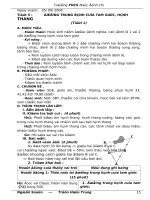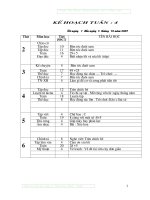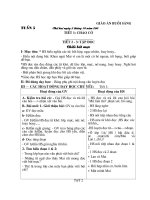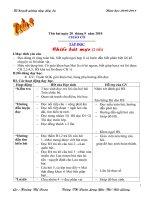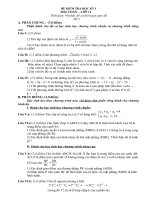5 6 2 saving an american symbol
Bạn đang xem bản rút gọn của tài liệu. Xem và tải ngay bản đầy đủ của tài liệu tại đây (7.21 MB, 14 trang )
Suggested levels for Guided Reading, DRA,™
Lexile,® and Reading Recovery™ are provided
in the Pearson Scott Foresman Leveling Guide.
Saving An
Genre
Expository
nonfiction
Comprehension
Skills and Strategy
• Main Idea and
Details
• Cause and Effect
• Text Structure
Text Features
•
•
•
•
Captions
Charts
Sidebars
Time Line
Scott Foresman Reading Street 5.6.2
ISBN 0-328-13580-1
ì<(sk$m)=bdfiag< +^-Ä-U-Ä-U
by Rena Korb
Reader Response
Saving An
1. Read the second paragraph on page 7. What is the
topic of the paragraph? Write the sentence that gives
the main idea of the paragraph. Then write three
details that support the main idea. Copy the chart
below and use it to record your answers.
Topic:
Main Idea:
Detail:
Detail:
Detail:
2. To organize their writing,By
authors use patterns, such
as making comparisons, describing problems and their
solutions, putting Rena
events in Korb
sequence or time order,
and describing causes and effects. What pattern did
the author use to organize this book? Explain your
answer.
3. The words wilderness and conservation are used on
page 11. Write the base word for each. Then use
the base words to help you write a definition for
wilderness and conservation.
4. Do you support the Yellowstone Buffalo Preservation
Act as it is described on page 22? Explain your answer.
Editorial Offices: Glenview, Illinois • Parsippany, New Jersey • New York, New York
Sales Offices: Needham, Massachusetts • Duluth, Georgia • Glenview, Illinois
Coppell, Texas • Ontario, California • Mesa, Arizona
Endless Herds
Imagine yourself standing on the Great Plains a
couple of hundred years ago. It’s springtime. The
prairie is bright green with new grass. Suddenly you
hear a far off rumble. The sky is cloudless. It can’t
be thunder. The rumbling grows louder. Then you
feel the ground shaking beneath your feet. And
finally you see the source. A sea of big brown beasts
spills over the horizon. It’s a huge herd of American
buffalo! Soon thousands of buffalo cover the prairie.
They stretch as far as you can see in every direction.
Every effort has been made to secure permission and provide appropriate credit for
photographic material. The publisher deeply regrets any omission and pledges to
correct errors called to its attention in subsequent editions.
Unless otherwise acknowledged, all photographs are the property of Scott Foresman,
a division of Pearson Education.
Photo locators denoted as follows: Top (T), Center (C), Bottom (B), Left (L), Right (R),
Background (Bkgd)
Opener, (C) ©Layne Kennedy/Corbis; (Bkgd) ©Lester Lefkowitz/Corbis: 1 ©W. Perry
Conway/Corbis: 3 ©Wolfgang Kaehler/Corbis: 6 ©Bettmann/Corbis: 7 ©Bettmann/
Corbis: 9 (T) ©Lowell Georgia/Corbis; (B) ©Corbis: 10 ©Corbis: 11 ©Corbis: 12 (T)
©Bettmann/Corbis; (Bkgd) ©Macduff Everton/Corbis: 14 (L) ©Bettmann/Corbis; (R)
©Underwood & Underwood/Corbis: 16 (T) ©Underwood & Underwood/Corbis; (B)
©Corbis: 17 ©Ron Sanford/Corbis: 19 ©James L. Amos/Corbis: 20 ©Lester Lefkowitz/
Corbis: 21 ©Corbis: 22 (L) ©Wally McNamee/Corbis; (R) ©Bettmann/Corbis: 23 (T) ©W.
Perry Conway/Corbis; (B) ©Layne Kennedy/Corbis
ISBN: 0-328-13580-1
Copyright © Pearson Education, Inc.
All Rights Reserved. Printed in the United States of America. This publication is
protected by Copyright, and permission should be obtained from the publisher
prior to any prohibited reproduction, storage in a retrieval system, or transmission
in any form by any means, electronic, mechanical, photocopying, recording, or
likewise. For information regarding permission(s), write to: Permissions Department,
Scott Foresman, 1900 East Lake Avenue, Glenview, Illinois 60025.
2 3 4 5 6 7 8 9 10 V0G1 14 13 12 11 10 09 08 07 06 05
This herd is lucky to be around. The American buffalo was near
extinction abuffalo
hundredon
years
American
the ago.
prairie
3
Great herds of American buffalo once covered
much of the continent. They lived west of the Rocky
Mountains, north almost to the tundra, throughout
the Great Plains, and east of the Mississippi River.
Until the mid-1830s, travelers on the Great Plains
saw huge buffalo herds almost everywhere. One
man reported that he waited five days for a herd
to pass. While the animals ran by, he tried to count
them. He estimated four million in the herd! When
the buffalo finally
stopped coming,
or
?
he measured their
American buffalo are not closely related
trail. It was 18
to the other buffalo of the world. India’s
miles wide! No
water buffalo and Africa’s Cape buffalo
are true buffaloes. American buffalo have
one imagined that
a much bigger head and huge humped
buffalo could
shoulders. American buffalo look more like
ever die out.
Buffalo B ison
Sacred Symbol of Survival
Native Americans hunted buffalo for thousands
of years before Europeans came to North America.
They hunted the large hoofed animals with bows and
arrows or spears. Buffalo were like a supermarket
for Plains Indians. They ate buffalo meat and made
clothing and shelters from buffalo hides. They used
buffalo bones to make tools and weapons. Buffalo
hooves were even boiled down to make glue.
No part of the buffalo was wasted. Many Native
American ceremonies honored the sacred buffalo,
from the large bulls to the scrawny newborn calves.
The tribes depended on them for survival.
Plains Indians depended on buffalo meat and hides for
survival. This made the buffalo a sacred animal.
European bison, their closest relatives.
4
5
American Buffalo Hunters
Life on the Great Plains changed when the
Europeans arrived. The new settlers didn’t see the
buffalo as a sacred animal to be respected and
honored. The Europeans saw buffalo hunting
as a way to make money, or something to
do for sport. By the early 1800s,
American buffalo hunters armed
with rifles arrived on the Plains.
Soon they were killing thousands
and thousands of buffalo.
William F. Cody earned the
nickname Buffalo Bill after he
killed 4,000 buffalo in just
one year.
6
A Coast-to-Coast Railroad
In the 1860s, construction began on the
transcontinental railroad. It would stretch from
the Atlantic Ocean to the Pacific. Buffalo hunters
followed the growing railroad. Some became
famous. Have you ever heard of Buffalo Bill? The
buffalo hunters killed
the animals to feed
the work crews. They
also hunted buffalo
to keep them off the
tracks.
Once the
transcontinental
railroad was finished,
things only got worse
for the buffalo. Railroad passengers killed
buffalo simply for
sport. Buffalo carcasses
Hunters keep the buffalo off
the tracks by shooting them.
soon dotted the Plains.
The great dead beasts
rotted in the sun. The stench of decay was in the
air. In 1869 one magazine writer described seeing a
railroad train with the passengers “shooting, from
every available window, with rifles, carbines, and
revolvers.”
7
The Disappearing Herds
MAINE
WASHINGTON
M O N T A N A
MINNESOTA
NORTH
DAKOTA
OREGON
VERMONT
NEW
HAMPSHIRE
NEW
YORK
WISCONSIN
SOUTH
DAKOTA
IDAHO
MICHIGAN
WYOMING
PENNSYLVANIA
N E B R A S K A
I O W A
O H I O
ILLINOIS
NEVADA
RHODE ISLAND
CONNECTICUT
NEW
JERSEY
MARYLAND DELAWARE
WEST
VIRGINIA
INDIANA
U T A H
MASSACHUSETTS
By the end of the 1870s, bleached buffalo
skeletons covered the Great Plains instead of
thundering herds. By the 1890s, Audubon’s
suspicions were coming true. The great wild herds of
buffalo weren’t endless like everyone had thought.
In fact, they were nearly gone.
VIRGINIA
C O L O R A D O
K A N S A S
CALIFORNIA
KENTUCKY
MISSOURI
NORTH
CAROLINA
TENNESSEE
OKLAHOMA
ARIZONA
N E W
M E X I C O
SOUTH
CAROLINA
ARKANSAS
MISSISSIPPI
GEORGIA
A L A BA M A
T
E
X
A
S
LOUISIANA
F L O R I DA
Bison Range
Range in 1500
Between 1872 and 1874,
American hunters killed close
to four million buffalo.
Range in 1870
By the 1840s, the buffalo were being killed at
increasingly high rates.
Unheard Warnings
Not all Americans approved of the buffalo hunts.
The famous naturalist John James Audubon spoke out
in 1843. “. . . Before many years the Buffalo, like the
Great Auk, will have disappeared,” he said. “Surely
this should not be permitted?” But most Americans
didn’t believe that the buffalo would become extinct.
Buffalo roamed in herds of millions, after all. No one
believed hunting them could ever make a difference.
In 1872, Dr. Brewster Higley wrote a famous poem,
“Home on the Range.” The first verse is “Oh, give me
a home, Where the buffalo roam, And the deer and
the antelope play.” Have you heard the folk song that
the poem became? Sadly, by the time Americans were
singing the song, a roaming buffalo was hard to find.
8
9
The End of a Way of Life
The killing of buffalo herds destroyed Native
American communities. The Plains Indians needed
their sacred buffalo to survive. Indian leaders
watched their people die of starvation without
buffalo meat. One Lakota who lived in the Dakotas
explained, “Wherever the whites are established, the
buffalo is gone.” Those days when life was easy for
Native Americans were now gone. Life for the Plains
Indians and the buffalo would never be the same.
The Birth of a Movement
Concerns over disappearing wildlife and wilderness
grew into America’s conservation movement. The
settlers who blanketed the young nation throughout
the 1800s had changed the land. They pulled down
the trees, plowed up prairies,
and built farms and towns. North
America was losing its natural
habitats and the wildlife that
depended on them.
Conservationist John Muir
was important in establishing
Yosemite National Park.
What Is
CONSERVATION?
Conservation is an effort to protect wildlife, plants, land, and
other natural resources from destruction during transformation.
The growing number of human beings has greatly changed
our planet. Cities, farms, and roads have replaced much
of the world’s wilderness, where wildlife once thrived.
Conservationists work to save wildlife and wilderness.
The loss of the buffalo herds changed the lives of
Plains Indians forever.
10
11
Early conservationists believed that the buffalo
mattered to North America. They set out to convince
Americans that the buffalo was worth saving.
Conservationist writer Ernest Baynes gave lectures
and showed people buffalo robes and artifacts.
He helped turn the buffalo into a symbol of the
American frontier.
Hornaday’s book The
Extermination of the American
Bison sounded a warning in 1889.
The beloved symbol of America,
the buffalo, was in danger
of disappearing forever. The
report called on national and
local governments to take
action to protect the buffalo.
As director of the Bronx
Zoological Park, he set up a
reserve for buffalo. William
Hornaday also helped save
the Alaskan fur seal and his
work led to the passage of
important conservation laws.
From Hunter to Crusader
William T. Hornaday was another important
early conservationist who helped save the buffalo.
Hornaday was a taxidermist. He preserved the
bodies of dead animals for display in places such
as museums. As Hornaday went about his work,
he became worried. He could see that there were
fewer and fewer buffalo. Hornaday knew that the
American buffalo was headed for extinction.
Milestones in Early Conservation
The U.S. Congress creates
the first national park,
called Yellowstone,
in Wyoming.
George Bird Grinnell
proposes an
organization
to protect birds.
1872
1860
1865
1864
George Perkins Marsh
writes the first textbook
on conservation,
Man and Nature.
12
1870
1886
1875
1880
1885
1876
1887
John Muir urges the
federal government
to preserve
America’s forests.
Theodore Roosevelt
founds the Boone and
Crockett Club to conserve
the habitat of wildlife.
The U.S. government creates
the first national forest reserve
in the area around Yellowstone
National Park.
William T. Hornaday raises
$100,000 to establish
the Permanent Wild Life
Protection Fund.
1891
1890
1915
1895
1900
1905
1910
1915
1903
President Theodore
Roosevelt begins the
National Wildlife
Refuge System.
13
Buffalo Wranglers and Ranchers
Some conservationists worked to change the
minds of Americans and lawmakers. Others cared for
the few buffalo left and tried to grow their herds. A
Native American man named Samuel Walking Coyote
saved several orphaned buffalo during the 1870s by
taking them to an Indian reservation.
Ranchers created their own buffalo
herds, too. Michel Pablo was a Montana
rancher who had worked as a “buffalo
runner” when he was a young man,
helping trap and hunt the great beasts.
But later in life he regretted his part
in the buffalo’s disappearance and
began buying buffalo to breed.
Hundreds of these buffalo later
started herds in Canada.
Rancher C.J. “Buffalo” Jones tried
to domesticate the buffalo. He
even trained several pairs of buffalo
to pull his wagon, instead of horses.
14
In 1872, the U.S. Congress created the country’s
first national park, Yellowstone. Within twenty years,
Congress had established three more national parks,
Yosemite, Sequoia, and Kings Canyon. By the early
1900s, large land areas had been set aside for wild
animals. Conservationists had a powerful friend in
the 26th U.S. President who served from 1901-1909.
Theodore Roosevelt was a naturalist. He understood
that our nation’s land and wildlife were precious
resources and worked to protect them.
Theodore Roosevelt said, “Wild beasts and birds are
by right not the property merely of people today
but the property of the unborn generations, whose
belongings we have no right to squander [waste].”
15
Hunters often illegally
killed buffalo in the early
days of Yellowstone
National Park.
The American Bison Society
The new law helped the buffalo at Yellowstone.
But Hornaday and other conservationists wanted to
put more buffalo herds on wildlife reserves and in
parks. To help win support, Hornaday founded the
American Bison Society in 1905.
Their efforts soon began to pay off. In 1907 the
U.S. Congress voted to create the first national
buffalo preserve. The 8,000-acre Wichita Mountains
refuge in Oklahoma soon became home to fifteen
buffalo.
You can still see buffalo at the country’s first
national buffalo preserve. Today it’s called
the Wichita Mountains Wildlife Refuge.
Buffalo Get Congressional Help
Yellowstone National Park has long been an
important home for American buffalo. Hunting isn’t
allowed in national parks. But during Yellowstone’s
first years, many hunters broke that rule. In the early
1890s Yellowstone officials were shocked when they
counted their buffalo. There were fewer than two
dozen! The U.S. Congress took action. In 1894, they
passed a law forbidding anyone from hunting or
harming wildlife in Yellowstone.
16
17
Year
Number of Buffalo Estimated
in the United States
Prior to the 1500s
30 to 70 million
1883
About 1,000
1889
About 550
1929
About 3,385
1934
About 4,000
1950
About 9,252
1970
About 17,000
2005
About 270,000
The National Bison Range is in Montana, where 40 buffalo
moved onto their new 18,000-acre home in 1909. Today 350
to 500 buffalo roam there.
This ranch is a lot like a cattle ranch. But instead
of beef cattle, ranchers raise buffalo to sell for meat.
Back from the Brink
By the 1930s, Hornaday and the other
conservationists had achieved their goal. The
American buffalo was saved from extinction.
The buffalo thrived in their parks and protected
reserves. By 1934, there were 4,000 buffalo living
in the United States. Three times that number
lived in Canada.
Over the next few decades, conservationists and
park rangers managed the buffalo in their care.
Part of that job was figuring out how many animals
could live comfortably within a certain area.
18
Park officials at Yellowstone kept their buffalo
population at around 400 for many decades. Park
rangers gave the buffalo hay, made sure they had
water, and kept predators away. But in 1967 they
decided to turn the herd over to nature. Rangers
stopped managing the buffalo in Yellowstone. There
are more than 3,000 buffalo in Yellowstone today.
Many different groups have worked to make
sure that buffalo never face extinction again.
The National Wildlife Federation keeps track of
the buffalo in Yellowstone, and tries to add more
buffalo to other national parks and reserves.
19
Conservationists around the world raised their
voices in protest. Many groups, such as the Humane
Society of the United States, are now demanding
that the legal buffalo killing stop. They point out
that there is no proof that cattle get the disease
from buffalo and that many of the buffalo killed
aren’t even infected.
A buffalo stops traffic in Yellowstone.
A Modern Buffalo Problem in Yellowstone
Buffalo are no longer in danger of extinction,
but they still have some problems. Like all animals,
buffalo can suffer from diseases and parasites. Years
ago, scientists discovered that some of the buffalo
in Yellowstone were infected with a disease. The
disease doesn’thurt the buffalo, but people worry
that they’llspread it to cattle. Yellowstone’s buffalo
sometimes move outside the park while searching
for food.
Scientists have found no case of the buffalo
giving cows their disease. But cattle
ranchers worry that it could happen
and have been given the right to kill
any buffalo that leaves Yellowstone.
Thousands of buffalo have been
killed over the years because of this
rule. Then, in 1996, ranchers killed 1,000
buffalo outside the park. This was one quarter of the
total herd living in Yellowstone!
20
Yellowstone’s buffalo are wild animals that roam
where they please. During the long winters, the buffalo
often wander outside the park in search of food.
21
reservations. They’d welcome the sacred buffalo back
to the land they once shared.
Today, people from all over the world visit the
buffalo at Yellowstone and other national parks
and reserves across the country. Visitors often see
a herd of buffalo thundering across the prairie, or
catch them rolling in the dust or mud. Whether
you call them buffalo or bison, the buffalo are an
amazing sight.
Conservation groups are working with
lawmakers to get the Yellowstone Buffalo
Preservation Act passed into law.
The Yellowstone Buffalo Preservation Act
Eventually, lawmakers took up the buffalo’s
battle again. In 2003 several members of the U.S.
Congress introduced a bill. The Yellowstone Buffalo
Preservation Act would allow wild buffalo to safely
visit nearby lands outside of Yellowstone National
Park. If the act is voted into law, it would outlaw the
harassment, capture, or killing of any buffalo unless
a person is in danger.
Conservationists say there are other ways to deal
with buffalo that wander outside Yellowstone. They
argue that there’s no reason to kill these magnificent
symbols of America’s wilderness. One suggestion
is to move the buffalo that leave Yellowstone to
tribal lands. Many Native American communities
are interested in having buffalo herds on their
22
Thanks to the work of early conservationists,
you can go buffalo-watching today.
23
Glossary
Reader Response
bleached adj. lightened in
color; white
scrawny adj. having little
flesh; lean; thin; skinny
carcasses n. dead bodies
of animals
starvation n. dying from
lack of food
decay n. the process of
rotting
suspicions n. beliefs;
feelings; thoughts
parasite n. any living
thing that lives on or
in another, from which
it gets its food, often
harming the other in the
process
tundra n. a vast, level,
treeless plain in the arctic
regions
1. Read the second paragraph on page 7. What is the
topic of the paragraph? Write the sentence that gives
the main idea of the paragraph. Then write three
details that support the main idea. Copy the chart
below and use it to record your answers.
Topic:
Main Idea:
Detail:
Detail:
Detail:
2. To organize their writing, authors use patterns, such
as making comparisons, describing problems and their
solutions, putting events in sequence or time order,
and describing causes and effects. What pattern did
the author use to organize this book? Explain your
answer.
3. The words wilderness and conservation are used on
page 11. Write the base word for each. Then use
the base words to help you write a definition for
wilderness and conservation.
4. Do you support the Yellowstone Buffalo Preservation
Act as it is described on page 22? Explain your answer.
24


